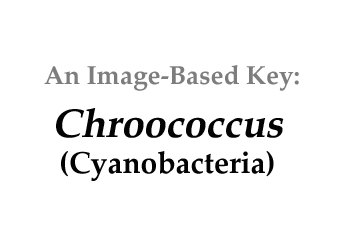|
Home / Cyanobacteria / Colonies / Chroococcus |
||||
|
|
||||
|
Click on images for larger format |
||||
Name derivation: |
||||
|
"Colored kernel" (From the Greek chroa, surface appearance or color of a thing, and kokkos, a kernel, a grain)
|
||||
Classification: |
||||
Chroococcus Nägeli 1849; 85 of 39 species descriptions are currently accepted taxonomically (Guiry and Guiry 2013).Order Chroococcales; Family ChroococcaceaeSome consider Chroococcus to be synonymous with Gloeocapsa (Adhikary et al. 1986).
|
||||
Morphology: |
||||
|
Single cells or cells in groups of a usually even number of cells (2 up to 32 - more frequently 2-4) inside mucilaginous envelope. Single cells are spherical, but when in groups they are often hemispherical due to the fact that daughter cells do not fully separate after division. Chroococcus has a dense sheath containing polymers of several sugars, mainly glucose (7.8 – 15%) and 2-O-Methyl-6-doxyhexose (6.2 – 11.9%) of dry weight depending on analytical method, along with four other sugars and amino acids, but ‘minimal’ lipids (Adhikary et al. 1986). Morphology of strains of Chroococcus in culture vary sufficiently under differing culture conditions (light, temperature, growth medium), as well as their 16S rRNA sequences, that they have been placed in five different genera including Eucapsis, Limnococcus, Gloeocapsa? and Synechocystis as well as Chroococcus itself (Komárková et al. 2010). The cautionary tale is that taxonomy based on morphology alone is insufficient and subject to error because of the impact of the microenvironment.
|
||||
Similar genera: |
||||
|
Colonies of the genus Gleocapsa contain more cells than those of Chroococcus.
|
||||
Optimal temperature: |
||||
Chroococcus minutus grew best at 30 – 38 C in a light intensity of 30 – 45 µM photons m‑2 s-1 (Huang et al. 2008).
|
||||
Habitat: |
||||
|
Widely distributed, with many species occurring in North America. Planktonic but also around aquatic plants in freshwater. Also in marine waters. |
||||
References: |
||||
|
Graham L. E. and L. W. Wilcox. 2000. Algae. Prentice Hall Guiry, M.D. and G.M. Guiry 2013. AlgaeBase. World-wide electronic publication, National University of Ireland, Galway. http://www.algaebase.org; searched on 04 September 2013. Huang, X., H. Pan, L. Zhuang, N. Liang-ping 2008. The cultivation and nutrition analysis of the blue-green alga Chroococcus minutes. Journal of Shanghai Fisheries University 2008-01. Jaeger E. C. 1955. A source-book of biological names and terms. Springfield: Charles C Thomas Publisher. John D. M., B. A. Whitton
and A. J. Brook, ed. 2008. Komárková, J., J. Jezberov Komárková, O. Komárek and E. Zapomĕlová 2010. Variability of Chroococcus (Cyanobacteria) morphospecies with regard to phylogenetic relationships. Hydrobiologia 639:69-83. Nägeli, C. 1849. Gattungen einzelliger Algen, physiologisch und systematisch bearbeitet. Neue Denkschriften der Allg. Schweizerischen Gesellschaft für die Gesammten Naturwissenschaften 10(7): i-viii, 1-139, pls I-VIII. Adhikary, S.P., J. Weckesser, U.J. Jűrgens, J.R. Golecki and D. Borowiak. 1986. Isolation and chemical characterization of the sheath from the cyanobacterium Chroococcus minutes SAG B.41.79. Journal of General Microbiology 132:2595-2599. Wehr J.D. and R. G. Sheath. 2003. Freshwater Algae
of |
||||
|
Home / Cyanobacteria / Colonies / Chroococcus |
||||







